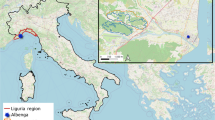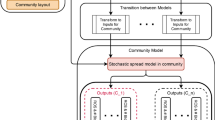Abstract
Wildfire evacuation triggers refer to prominent geographic features used in wildfire evacuation practices, and when a fire crosses a feature, an evacuation warning is issued to the communities or firefighters in the path of the fire. The existing wildfire trigger modeling methods consider evacuation time as an input from a decision maker and employ fire spread modeling and GIS to create a trigger buffer around a threatened asset. This paper substantially improves on previous methods by coupling fire and traffic simulation models to set triggers, which allows us to estimate evacuation time using a traffic simulation model rather than relying on expert judgment. Specifically, we propose a three-step method within a spatiotemporal GIS framework to couple these models and to evaluate the value of the generated trigger buffers. The first step uses traffic simulation to estimate the total evacuation time for a threatened community. The second step derives the cumulative probabilities for distinct evacuation times from multiple simulations and generates corresponding probability-based trigger buffers. In the last step, we evaluate the value of the generated buffers by coupling fire and traffic simulation models to examine the spatial configurations of fire perimeters and evacuation traffic. A case study of Julian, California is used to test the proposed method. The results from two evacuation scenarios with different travel demand indicate that a larger trigger buffer (more lead time) will be needed for higher levels of evacuation travel demand. For example, the time required to guarantee that 95% of the evacuating residents arrive at the safe area as a fire approaches a community is estimated at 160 min for one scenario but 292 min if the travel demand is doubled. The resulting framework advances the dynamic representation of evacuation traffic in wildfires and improves our understanding of wildfire evacuation timing and decision making. The paper concludes with a discussion of the strengths and limitations of the proposed method, as well as future research directions.












Similar content being viewed by others
References
Westerling AL, Hidalgo HG, Cayan DR, Swetnam TW (2006) Warming and earlier spring increase Western U.S. forest wildfire activity. Science 313(5789):940–943. https://doi.org/10.1126/science.1128834
Dennison PE, Brewer SC, Arnold JD, Moritz MA (2014) Large wildfire trends in the western United States, 1984–2011. Geophys Res Lett 41(8):2928–2933. https://doi.org/10.1002/2014gl059576
Stewart SI, Radeloff VC, Hammer RB, Hawbaker TJ (2007) Defining the wildland-urban interface. J Forest 105(4):201–207
Hammer RB, Stewart SI, Radeloff VC (2009) Demographic trends, the wildland–urban interface, and wildfire management. Soc Nat Resour 22(8):777–782. https://doi.org/10.1080/08941920802714042
Brenkert–Smith H, Champ PA, Flores N (2006) Insights into wildfire mitigation decisions among wildland–urban interface residents. Soc Nat Resour 19(8):759–768. https://doi.org/10.1080/08941920600801207
Cova TJ (2005) Public safety in the urban–wildland interface: should fire-prone communities have a maximum occupancy? Nat Hazards Rev 6(3):99–108. https://doi.org/10.1061/(asce)1527-6988(2005)6:3(99)
Cova TJ, Theobald DM, Norman JB, Siebeneck LK (2013) Mapping wildfire evacuation vulnerability in the western US: the limits of infrastructure. GeoJournal 78(2):273–285. https://doi.org/10.1007/s10708-011-9419-5
Paveglio T, Carroll MS, Jakes PJ (2008) Alternatives to evacuation—protecting public safety during wildland fire. J Forest 106(2):65–70
Cova TJ, Drews FA, Siebeneck LK, Musters A (2009) Protective actions in wildfires: evacuate or shelter-in-place? Nat Hazards Rev 10(4):151–162. https://doi.org/10.1061/(asce)1527-6988(2009)10:4(151)
Tibbits A, Whittaker J (2007) Stay and defend or leave early: policy problems and experiences during the 2003 Victorian bushfires. Environ Hazards 7(4):283–290. https://doi.org/10.1016/j.envhaz.2007.08.001
McNeill IM, Dunlop PD, Skinner TC, Morrison DL (2015) Predicting delay in residents’ decisions on defending v. evacuating through antecedents of decision avoidance. Int J Wildland Fire 24(2):153–161. https://doi.org/10.1071/wf12213
Drews FA, Musters A, Siebeneck LK, Cova TJ (2014) Environmental factors that influence wildfire protective-action recommendations. Int J Emerg Manag 10(2):153–168. https://doi.org/10.1504/ijem.2014.066187
McCaffrey S, Wilson R, Konar A (2017) Should I stay or should I go now? Or should I wait and see? Influences on wildfire evacuation decisions. Risk Anal. https://doi.org/10.1111/risa.12944
Handmer J, Tibbits A (2005) Is staying at home the safest option during bushfires? Historical evidence for an Australian approach. Glob Environ Change B Environ Hazards 6(2):81–91. https://doi.org/10.1016/j.hazards.2005.10.006
Lindell MK (2008) EMBLEM2: an empirically based large scale evacuation time estimate model. Trans Res A Policy Pract 42(1):140–154. https://doi.org/10.1016/j.tra.2007.06.014
Cook R (2003) Show Low, Arizona, inferno: evacuation lessons learned in the Rodeo–Chedeski fire. NFPA J 97(2):10–14
Meyer JP (2012) Report: city was not slow to order Waldo Canyon evacuations. The Denver Post. https://www.denverpost.com/2012/10/23/report-city-was-not-slow-to-order-waldo-canyon-evacuations/. Accessed 18 Feb 2018
Cova TJ, Dennison PE, Kim TH, Moritz MA (2005) Setting wildfire evacuation trigger points using fire spread modeling and GIS. Trans GIS 9(4):603–617. https://doi.org/10.1111/j.1467-9671.2005.00237.x
Dennison PE, Cova TJ, Moritz MA (2007) WUIVAC: a wildland-urban interface evacuation trigger model applied in strategic wildfire scenarios. Nat Hazards 41(1):181–199. https://doi.org/10.1007/s11069-006-9032-y
Fryer GK, Dennison PE, Cova TJ (2013) Wildland firefighter entrapment avoidance: modelling evacuation triggers. Int J Wildland Fire 22(7):883–893. https://doi.org/10.1071/wf12160
Li D, Cova TJ, Dennison PE (2017) Using reverse geocoding to identify prominent wildfire evacuation trigger points. Appl Geogr 87:14–27. https://doi.org/10.1016/j.apgeog.2017.05.008
Southworth F (1991) Regional evacuation modeling: a state-of-the-art review. Oak Ridge National Laboratory, Oak Ridge
Pel AJ, Bliemer MC, Hoogendoorn SP (2012) A review on travel behaviour modelling in dynamic traffic simulation models for evacuations. Transportation 39(1):97–123. https://doi.org/10.1007/s11116-011-9320-6
Wilmot C, Meduri N (2005) Methodology to establish hurricane evacuation zones. Transp Res Rec J Transp Res Board 1922:129–137. https://doi.org/10.3141/1922-17
Cova TJ, Johnson JP (2002) Microsimulation of neighborhood evacuations in the urban - wildland interface. Environ Plan A 34(12):2211–2229. https://doi.org/10.1068/a34251
Lindell MK, Prater CS (2007) Critical behavioral assumptions in evacuation time estimate analysis for private vehicles: examples from hurricane research and planning. J Urban Plan Dev 133 (1):18–29. https://doi.org/10.1061/(asce)0733-9488(2007)133:1(18)
Tweedie SW, Rowland JR, Walsh SJ, Rhoten RP, Hagle PI (1986) A methodology for estimating emergency evacuation times. Soc Sci J 23(2):189–204. https://doi.org/10.1016/0362-3319(86)90035-2
Chen X, Meaker JW, Zhan FB (2006) Agent-based modeling and analysis of hurricane evacuation procedures for the florida keys. Nat Hazards 38(3):321–338. https://doi.org/10.1007/s11069-005-0263-0
Chen X, Zhan FB (2008) Agent-based modelling and simulation of urban evacuation: relative effectiveness of simultaneous and staged evacuation strategies. J Oper Res Soc 59(1):25–33
Rothermel RC (1972) A mathematical model for predicting fire spread in wildland fuels. USDA Forest Service, Intermountain Forest & Range Experiment Station, Ogden, UT
Finney MA (2006) An overview of FlamMap fire modeling capabilities. Fuels Management—How to Measure Success: Conference Proceedings. USDA Forest Service, Rocky Mountain Research Station, Fort Collins, CO
Finney MA (1998) FARSITE: Fire Area Simulator—model development and evaluation. USDA Forest Service, Rocky Mountain Research Station, Ogden, UT
Van Wagner CE (1969) A simple fire-growth model. For Chron 45(2):103–104. https://doi.org/10.5558/tfc45103-2
Finney MA (2002) Fire growth using minimum travel time methods. Can J For Res 32(8):1420–1424. https://doi.org/10.1139/x02-068
Clarke KC, Brass JA, Riggan PJ (1994) A cellular automation model of wildfire propagation and extinction. Photogramm Eng Remote Sensing 60(11):1355–1367
Dijkstra EW (1959) A note on two problems in connexion with graphs. Numer Math 1(1):269–271. https://doi.org/10.1007/bf01386390
Larsen JC, Dennison PE, Cova TJ, Jones C (2011) Evaluating dynamic wildfire evacuation trigger buffers using the 2003 Cedar Fire. Appl Geogr 31(1):12–19. https://doi.org/10.1016/j.apgeog.2010.05.003
Li D, Cova TJ, Dennison PE (2015) A household-level approach to staging wildfire evacuation warnings using trigger modeling. Comput Environ Urban Syst 54:56–67. https://doi.org/10.1016/j.compenvurbsys.2015.05.008
Anguelova Z, Stow DA, Kaiser J, Dennison PE, Cova TJ (2010) Integrating fire behavior and pedestrian mobility models to assess potential risk to humans from wildfires within the U.S.–Mexico Border Zone. Prof Geogr 62(2):230–247. https://doi.org/10.1080/00330120903543756
Langran G, Chrisman NR (1988) A framework for temporal geographic information. Cartographica 25(3):1–14. https://doi.org/10.3138/k877-7273-2238-5q6v
Peuquet D (2001) Making space for time: issues in space-time data representation. GeoInformatica 5(1):11–32. https://doi.org/10.1023/a:1011455820644
Hägerstraand T (1970) What about people in regional science? Pap Reg Sci 24(1):7–24. https://doi.org/10.1111/j.1435-5597.1970.tb01464.x
Miller HJ, Shaw S-L (2015) Geographic information systems for transportation in the 21st century. Geogr Compass 9(4):180–189. https://doi.org/10.1111/gec3.12204
Cova TJ, Dennison PE, Li D, Drews FA, Siebeneck LK, Lindell MK (2017) Warning triggers in environmental hazards: who should be warned to do what and when? Risk Anal 37(4):601–611. https://doi.org/10.1111/risa.12651
Pultar E, Raubal M, Cova TJ, Goodchild MF (2009) Dynamic GIS case studies: wildfire evacuation and volunteered geographic information. Trans GIS 13:85–104. https://doi.org/10.1111/j.1467-9671.2009.01157.x
Pultar E, Cova TJ, Yuan M, Goodchild MF (2010) EDGIS: a dynamic GIS based on space time points. Int J Geogr Inf Sci 24(3):329–346. https://doi.org/10.1080/13658810802644567
Yuan M (2001) Representing complex geographic phenomena in GIS. Cartogr Geogr Inf Sci 28(2):83–96. https://doi.org/10.1559/152304001782173718
Miller HJ, Wentz EA (2003) Representation and spatial analysis in geographic information systems. Ann Assoc Am Geogr 93(3):574–594. https://doi.org/10.1111/1467-8306.9303004
Janelle DG (1969) Spatial reorganization: a model and concept. Ann Assoc Am Geogr 59(2):348–364. https://doi.org/10.1111/j.1467-8306.1969.tb00675.x
Gatrell AC (1983) Distance and space: a geographical perspective. Oxford University Press, New York, NY
Li D (2016) Modeling wildfire evacuation as a coupled human-environmental system using triggers. Dissertation, The University of Utah
Yuan M (1997) Use of knowledge acquisition to build wildfire representation in geographical information systems. Int J Geogr Inf Sci 11(8):723–746. https://doi.org/10.1080/136588197242059
Wolshon B, Marchive E (2007) Emergency planning in the urban-wildland interface: subdivision-level analysis of wildfire evacuations. J Urban Plan Dev 133(1):73–81. https://doi.org/10.1061/(asce)0733-9488(2007)133:1(73)
Han L, Yuan F, Urbanik T (2007) What is an effective evacuation operation? J Urban Plan Dev 133(1):3–8. https://doi.org/10.1061/(asce)0733-9488(2007)133:1(3)
Beloglazov A, Almashor M, Abebe E, Richter J, Steer KCB (2016) Simulation of wildfire evacuation with dynamic factors and model composition. Simul Model Pract Theory 60:144–159. https://doi.org/10.1016/j.simpat.2015.10.002
Lämmel G, Grether D, Nagel K (2010) The representation and implementation of time-dependent inundation in large-scale microscopic evacuation simulations. Trans Res C Emerg Technol 18(1):84–98. https://doi.org/10.1016/j.trc.2009.04.020
Haklay M, Weber P (2008) Open street map: user-generated street maps. IEEE Pervasive Comput 7(4):12–18. https://doi.org/10.1109/mprv.2008.80
Goetz M, Zipf A (2012) Using crowdsourced geodata for agent-based indoor evacuation simulations. ISPRS Int J Geoinf 1(2):186
Rollins MG (2009) LANDFIRE: a nationally consistent vegetation, wildland fire, and fuel assessment. Int J Wildland Fire 18(3):235–249. https://doi.org/10.1071/wf08088
Dennison PE, Moritz MA (2009) Critical live fuel moisture in chaparral ecosystems: a threshold for fire activity and its relationship to antecedent precipitation. Int J Wildland Fire 18(8):1021–1027. https://doi.org/10.1071/wf08055
Church RL, Cova TJ (2000) Mapping evacuation risk on transportation networks using a spatial optimization model. Trans Res C Emerg Technol 8(1–6):321–336. https://doi.org/10.1016/s0968-090x(00)00019-x
Cova TJ, Church RL (1997) Modelling community evacuation vulnerability using GIS. Int J Geogr Inf Sci 11(8):763–784. https://doi.org/10.1080/136588197242077
Murray-Tuite P, Wolshon B (2013) Evacuation transportation modeling: an overview of research, development, and practice. Trans Res C Emerg Technol 27:25–45. https://doi.org/10.1016/j.trc.2012.11.005
Kobayashi T, Medina RM, Cova TJ (2011) Visualizing diurnal population change in urban areas for emergency management. Prof Geogr 63(1):113–130. https://doi.org/10.1080/00330124.2010.533565
Bekhor S, Dobler C, Axhausen K (2011) Integration of activity-based and agent-based models. Transp Res Rec J Transp Res Board 2255:38–47. https://doi.org/10.3141/2255-05
Fu H, Wilmot C (2004) Sequential logit dynamic travel demand model for hurricane evacuation. Transp Res Rec J Transp Res Board 1882:19–26. https://doi.org/10.3141/1882-03
Arlikatti S, Lindell MK, Prater CS, Zhang Y (2006) Risk area accuracy and hurricane evacuation expectations of coastal residents. Environ Behav 38(2):226–247. https://doi.org/10.1177/0013916505277603
Zhang Y, Prater CS, Lindell MK (2004) Risk area accuracy and evacuation from hurricane bret. Nat Hazards Rev 5(3):115–120. https://doi.org/10.1061/(asce)1527-6988(2004)5:3(115)
Kim T, Cova T, Brunelle A (2006) Exploratory map animation for post-event analysis of wildfire protective action recommendations. Nat Hazards Rev 7(1):1–11. https://doi.org/10.1061/(asce)1527-6988(2006)7:1(1)
Cova TJ, Dennison PE, Drews FA (2011) Modeling evacuate versus shelter-in-place decisions in wildfires. Sustainability 3(10):1662. https://doi.org/10.3390/su3101662
Lindell MK, Prater CS (2007) A hurricane evacuation management decision support system (EMDSS). Nat Hazards 40(3):627–634. https://doi.org/10.1007/s11069-006-9013-1
Reid CE, Brauer M, Johnston FH, Jerrett M, Balmes JR, Elliott CT (2016) Critical review of health impacts of wildfire smoke exposure. Environ Health Perspect 124(9):1334–1343. https://doi.org/10.1289/ehp.1409277
Acknowledgements
This research was funded by National Science Foundation CMMI-IMEE grant number 1100890. We thank the anonymous reviewers for their comments and suggestions. Lastly, the support and resources from the Center for High Performance Computing at the University of Utah are also gratefully acknowledged.
Author information
Authors and Affiliations
Corresponding author
Additional information
Publisher's Note
Springer Nature remains neutral with regard to jurisdictional claims in published maps and institutional affiliations.
Appendix 1
Rights and permissions
About this article
Cite this article
Li, D., Cova, T.J. & Dennison, P.E. Setting Wildfire Evacuation Triggers by Coupling Fire and Traffic Simulation Models: A Spatiotemporal GIS Approach. Fire Technol 55, 617–642 (2019). https://doi.org/10.1007/s10694-018-0771-6
Received:
Accepted:
Published:
Issue Date:
DOI: https://doi.org/10.1007/s10694-018-0771-6




